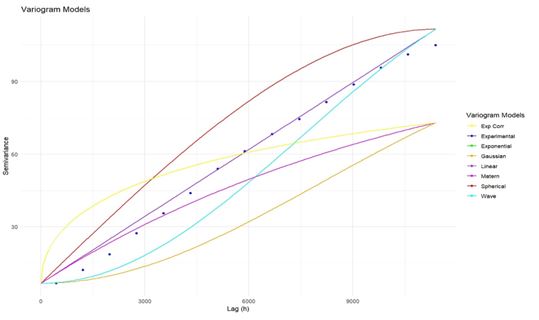Spatio-Temporal Dynamics of Ground Water Level of Lahore Metropolitan and its Relationship with Urbanization and Rainfall
Keywords:
Lahore, Population, Rainfall, Ground water, Google Earth Engine (GEE), R Studio, Krigging, Land use/ Land cover, UrbanizationAbstract
Introduction/Importance of Study: Lahore, the capital of Punjab Province, has a population of 14.1 million people. The city relies entirely on groundwater to meet its water needs. However, unsustainable water usage has led to a significant decline in groundwater levels.
Novelty Statement: This study aims to investigate the root causes of groundwater depletion in Lahore and propose effective protective measures. The excessive extraction from around 600 tube wells, some reaching depths of 600 to 1000 feet, has resulted in non-functional wells and severe water shortages.
Material and Method: The study employed various tools and techniques, including Google Earth Engine, image classification methods, and R Studio (ordinary Kriging). An overlay analysis assessed the spatial relationship between land use/land cover and groundwater levels. The analysis revealed a significant correlation between urbanization, population growth, and groundwater depletion in Lahore.
Results and Discussion: The rate of groundwater depletion has increased from an average of 2.133 feet per year (0.65 meters per year) between 1980 and 2000 to over 3 feet per year (over 1 meter per year) since 2013. Contributing factors include rapid urbanization, increased water demand due to population growth, and inadequate rainwater recharge. This rapid depletion poses a serious threat to Lahore's groundwater resources, emphasizing the urgent need for sustainable water management practices.
Concluding Remarks: The rapid depletion of groundwater is a critical issue for Lahore, necessitating immediate implementation of sustainable water management practices and groundwater recharge strategies. Effective measures are essential to mitigate the impacts of rapid urbanization and population growth on groundwater resources, ensuring a reliable water supply for the future.
References
O. Ali, A. Ali, M. Shakir, S. Riaz, S. Iqbal, and E. Zahid, “Lahore: ground water depth analysis and its impact on water parameters,” Authorea Prepr., Nov. 2022, doi: 10.1002/ESSOAR.10510712.1.
C. Okello, B. Tomasello, N. Greggio, N. Wambiji, and M. Antonellini, “Impact of Population Growth and Climate Change on the Freshwater Resources of Lamu Island, Kenya,” Water 2015, Vol. 7, Pages 1264-1290, vol. 7, no. 3, pp. 1264–1290, Mar. 2015, doi: 10.3390/W7031264.
W. A. C. Udeshani, H. M. K. P. Dissanayake, S. K. Gunatilake, and R. Chandrajith, “Assessment of groundwater quality using water quality index (WQI): A case study of a hard rock terrain in Sri Lanka,” Groundw. Sustain. Dev., vol. 11, p. 100421, Oct. 2020, doi: 10.1016/J.GSD.2020.100421.
N. Gupta, P. Pandey, and J. Hussain, “Effect of physicochemical and biological parameters on the quality of river water of Narmada, Madhya Pradesh, India,” Water Sci., vol. 31, no. 1, pp. 11–23, 2017, doi: 10.1016/J.WSJ.2017.03.002.
B. R. Scanlon et al., “Groundwater depletion and sustainability of irrigation in the US High Plains and Central Valley,” Proc. Natl. Acad. Sci. U. S. A., vol. 109, no. 24, pp. 9320–9325, Jun. 2012, doi: 10.1073/PNAS.1200311109/SUPPL_FILE/PNAS.201200311SI.PDF.
S. Ashraf, A. Nazemi, and A. AghaKouchak, “Anthropogenic drought dominates groundwater depletion in Iran,” Sci. Reports 2021 111, vol. 11, no. 1, pp. 1–10, Apr. 2021, doi: 10.1038/s41598-021-88522-y.
S. Cao, J. Zhang, L. Chen, and T. Zhao, “Ecosystem water imbalances created during ecological restoration by afforestation in China, and lessons for other developing countries,” J. Environ. Manage., vol. 183, pp. 843–849, Dec. 2016, doi: 10.1016/J.JENVMAN.2016.07.096.
E. Jéquier and F. Constant, “Water as an essential nutrient: the physiological basis of hydration,” Eur. J. Clin. Nutr. 2010 642, vol. 64, no. 2, pp. 115–123, Sep. 2009, doi: 10.1038/ejcn.2009.111.
G. Cao, C. Zheng, B. R. Scanlon, J. Liu, and W. Li, “Use of flow modeling to assess sustainability of groundwater resources in the North China Plain,” Water Resour. Res., vol. 49, no. 1, pp. 159–175, Jan. 2013, doi: 10.1029/2012WR011899.
J. M. Deines, A. D. Kendall, J. J. Butler, and D. W. Hyndman, “Quantifying irrigation adaptation strategies in response to stakeholder-driven groundwater management in the US High Plains Aquifer,” Environ. Res. Lett., vol. 14, no. 4, p. 044014, Apr. 2019, doi: 10.1088/1748-9326/AAFE39.
H. Bouwer, “Artificial recharge of groundwater: Hydrogeology and engineering,” Hydrogeol. J., vol. 10, no. 1, pp. 121–142, Feb. 2002, doi: 10.1007/S10040-001-0182-4/METRICS.
C. R. Jackson, R. Meister, and C. Prudhomme, “Modelling the effects of climate change and its uncertainty on UK Chalk groundwater resources from an ensemble of global climate model projections,” J. Hydrol., vol. 399, no. 1–2, pp. 12–28, Mar. 2011, doi: 10.1016/J.JHYDROL.2010.12.028.
C. E. Graniel, L. B. Morris, and J. J. Carrillo-Rivera, “Effects of urbanization on groundwater resources of Merida, Yucatan, Mexico,” Environ. Geol., vol. 37, no. 4, pp. 303–312, Apr. 1999, doi: 10.1007/S002540050388/METRICS.
H. Blanco, P. McCarney, S. Parnell, M. Schmidt, and K. C. Seto, “The role of urban land in climate change,” Clim. Chang. Cities, pp. 217–248, Aug. 2011, doi: 10.1017/CBO9780511783142.014.
C. L. Arnold and C. J. Gibbons, “Impervious Surface Coverage: The Emergence of a Key Environmental Indicator,” J. Am. Plan. Assoc., vol. 62, no. 2, pp. 243–258, 1996, doi: 10.1080/01944369608975688.
A. F. Alqurashi and L. Kumar, “An assessment of the impact of urbanization and land use changes in the fast-growing cities of Saudi Arabia,” Geocarto Int., vol. 34, no. 1, pp. 78–97, Jan. 2019, doi: 10.1080/10106049.2017.1367423.
S. Chapman, J. E. M. Watson, A. Salazar, M. Thatcher, and C. A. McAlpine, “The impact of urbanization and climate change on urban temperatures: a systematic review,” Landsc. Ecol. 2017 3210, vol. 32, no. 10, pp. 1921–1935, Aug. 2017, doi: 10.1007/S10980-017-0561-4.
S. Chen, W. B. Li, Y. D. Du, C. Y. Mao, and L. Zhang, “Urbanization effect on precipitation over the Pearl River Delta based on CMORPH data,” Adv. Clim. Chang. Res., vol. 6, no. 1, pp. 16–22, Mar. 2015, doi: 10.1016/J.ACCRE.2015.08.002.
E. Khazaei, R. Mackay, and J. W. Warner, “The Effects of Urbanization on Groundwater Quantity and Quality in the Zahedan Aquifer, southeast Iran,” Water Int., 2004, doi: 10.1080/02508060408691767.

Downloads
Published
How to Cite
Issue
Section
License
Copyright (c) 2024 50SEA

This work is licensed under a Creative Commons Attribution 4.0 International License.




















